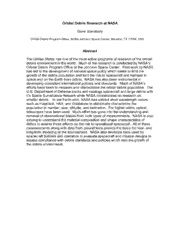
NASA Technical Reports Server (NTRS) 20090017678: Orbital Debris Research at NASA PDF
Preview NASA Technical Reports Server (NTRS) 20090017678: Orbital Debris Research at NASA
Orbital Debris Research at NASA Gene Stansbery Orbital Debris Program Office, NASA Johnson Space Center, Houston, TX 77058, USA Abstract The United States has one of the most active programs of research of the orbital debris environment in the world. Much of the research is conducted by NASA’s Orbital Debris Program Office at the Johnson Space Center. Past work by NASA has led to the development of national space policy which seeks to limit the growth of the debris population and limit the risk to spacecraft and humans in space and on the Earth from debris. NASA has also been instrumental in developing consistent international policies and standards. Much of NASA’s efforts have been to measure and characterize the orbital debris population. The U.S. Department of Defense tracks and catalogs spacecraft and large debris with it’s Space Surveillance Network while NASA concentrates on research on smaller debris. In low Earth orbit, NASA has utilized short wavelength radars such as Haystack, HAX, and Goldstone to statistically characterize the population in number, size, altitude, and inclination. For higher orbits, optical telescopes have been used. Much effort has gone into the understanding and removal of observational biases from both types of measurements. NASA is also striving to understand the material composition and shape characteristics of debris to assess these effects on the risk to operational spacecraft. All of these measurements along with data from ground tests provide the basis for near- and long-term modeling of the environment. NASA also develops tools used by spacecraft builders and operators to evaluate spacecraft and mission designs to assess compliance with debris standards and policies which limit the growth of the debris environment.
